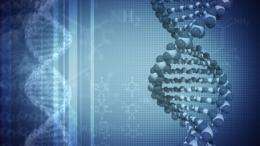Scientists find way to predict and control gene expression

(Medical Xpress)—EPFL scientists have developed a "guide" that can be used to precisely predict the number of proteins a given gene will produce under varying conditions. This work will help biologists to engineer cells.
Genes are segments of DNA within our cells that oversee how our bodies take shape. They receive orders to produce specific proteins; these proteins become the building blocks of everything in our body, from organs to the hemoglobin in our red blood cells. Our genes are thus at the very center of who we are.
The processes at work in producing proteins from genes, also called gene expression, are extremely complex and depend on many different factors that are all interconnected. Proteins affect genes, which in turn affect proteins, and biologists don't yet fully understand just how it all works and what controls the system.
EPFL graduate students Arun Rajkumar and Nicolas Denervaud, together with the researcher Sebastian Maerkl recently shed some light on these processes. They developed a guide to gene expression that shows how the amount of proteins produced can be controlled. The results of the study have been published in Nature Genetics.
Genes aren't simply switched "on" or "off"
Each gene has a segment of DNA at its beginning called a promoter, which plays a key role in making proteins. When the promoter is activated, it produces a molecule called mRNA, which then becomes a protein. But genes genes aren't simply turned "on" or "off", and the amount of proteins that they produce can vary. Researchers in the Maerkl lab have developed a model that accounts for all the variations that can occur between "on" and "off."
More like a dimmer switch than an on/off button
The team worked with yeast cells, which serve as a model system for many processes occurring in human cells. They generated 209 different promoters and integrated them into the yeast genome. They then placed the 209 yeast strains in a microfluidic device and used fluorescence-based methods to determine the number of proteins produced form each of the 209 synthetic promoters. "Our in vivo results lined up with what we'd already seen in vitro. That meant we could develop a computational model that predicts the level of gene expression on the basis of in vitro data". Concretely, this work represents a "gene-expression instruction manual" that predicts how different promoter structures can give rise to varying amounts of protein. "We show that promoter output can be precisely tuned with just one or two changes to the promoter, a bit like a dimmer switch on a lamp that allows one to set any light level," says Professor Maerkl.
Are custom-engineered cells on the horizon?
Professor Maerkl's work, which could be applicable to all yeast promoters, represents an important breakthrough because it provides insight into biological processes that will advance our ability to engineer cells. "We're only just beginning to understand the phenomena involved here," says Professor Maerkl, "but the work is promising. If we can understand the biology better we should be able to artificially engineer better-performing cells - cells that are optimal for producing biofuels or antimalarial drugs, for example."
The paper is titled "Mapping the fine structure of a eukaryotic promoter input-output function."
More information: www.nature.com/ng/journal/vaop … nt/full/ng.2729.html




















